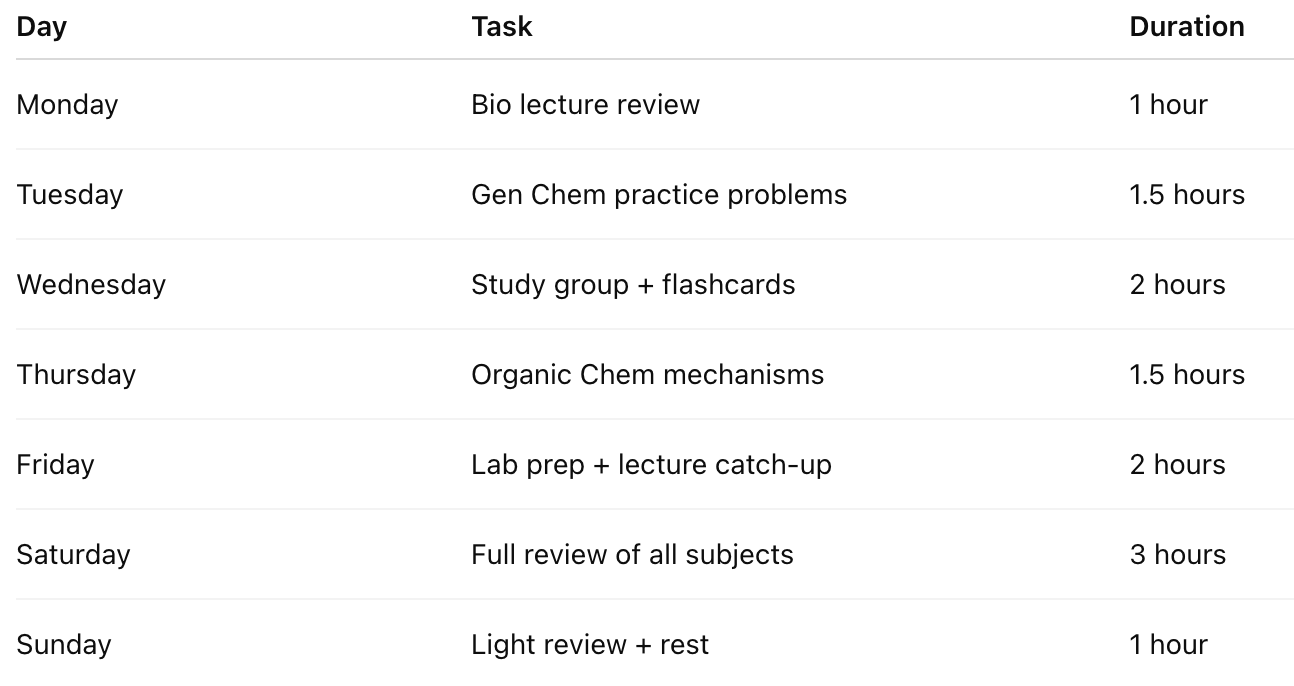How to Build a Study Schedule for College Science Courses
Ace Biology, Chemistry, and More with a Smart, Sustainable Plan
Struggling to stay on top of your science courses? Learn how to build an effective, flexible study schedule for college biology, chemistry, and other STEM classes—designed for long-term success.
Why a Study Schedule Is Essential for College Science Courses
College-level science courses are fast-paced, dense, and often cumulative. Between complex lectures, labs, and high-stakes exams, it’s easy to fall behind without a solid system in place. Whether you're taking general biology, chemistry, organic chemistry, or physics, having a strategic study schedule can make the difference between survival and success.
In this post, we’ll walk you through step-by-step how to build a study schedule that works—one that’s realistic, flexible, and optimized for science-heavy workloads.
Step 1: Audit Your Weekly Commitments
Before you build a study plan, you need to understand your time constraints. Start by listing:
Class times and labs
Work or extracurricular commitments
Meals, exercise, and sleep
Free blocks of time
Tip: Use a digital calendar like Google Calendar to visualize your week. Color-code different types of commitments to see where study time can realistically fit.
Step 2: Break Down Each Science Course
Treat each science course as its own project. For each class:
List how often lectures and labs occur
Identify major exam dates and weekly quizzes
Estimate hours needed per week (lecture review, problem sets, lab write-ups)
Example:
General Chemistry: 3 hours lecture + 1 lab/week
→ 6–8 hours/week of outside study time (review notes, do practice problems, prep for lab)
Step 3: Use the “1 Hour In, 2 Hours Out” Rule
A general rule for STEM success: For every 1 hour in class, spend 2 hours reviewing.
That means a 3-credit biology course may require up to 6 hours of weekly study time. For science-heavy students, this can quickly add up, so prioritize early and front-load your schedule to prevent burnout later in the semester.
Step 4: Create a Weekly Study Template
Now that you know what to study and how long it takes, build a weekly template. Include:
Lecture review blocks (within 24 hours of class)
Daily mini-sessions for spaced repetition
Dedicated problem-solving sessions for chemistry or physics
Weekend review blocks to reinforce material
Sample Weekly Template:
Step 5: Use Study Methods That Work for Science
Not all study time is created equal. Science courses demand active recall and practice-based learning. Some of the best methods include:
Spaced repetition (use apps like Anki)
Practice problems and old exams
Teaching the material to someone else
Drawing diagrams or flowcharts
Lab summary sheets
Avoid passive strategies like re-reading or highlighting—these may feel productive but yield low retention.
Step 6: Build in Flexibility and Recovery
No schedule should be rigid. Life happens—so plan for:
Buffer time each week (2–3 hours)
Rest days to prevent burnout
Mental health check-ins during midterms/finals
Think of your schedule as a living document—something you can adapt, not a fixed rulebook.
Step 7: Evaluate and Adjust Weekly
At the end of each week, ask:
Did I stick to the plan?
What helped me stay focused?
What didn’t work?
Use this feedback to adjust your strategy for the next week. Staying adaptable is key to long-term academic success, especially in demanding science courses.
Final Thoughts: A Study Schedule Is a Strategy, Not a Struggle
College science courses are intense—but with the right planning and tools, you don’t have to sacrifice your sanity or sleep. The best study schedules are sustainable, flexible, and built around active learning strategies.
Need Personalized Help with Science Courses?
At Dental School Declassified, we offer 1:1 tutoring from licensed dentists and top-tier tutors who’ve been through the toughest science courses—and aced them. Whether you need help with Organic Chemistry, Biology, or DAT prep, we’ll build a plan that works for you.
